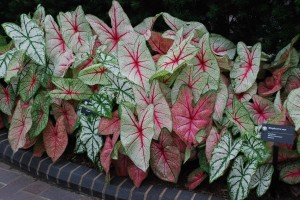Caladiums (Caladium bicolor) are tropical foliage plants which are grown as annuals. Caladiums brighten up shady to sunny spots. Their brightly colored foliage is either heart and lanced shaped in color combinations ranging from red, rose, pink, chartreuse, green, and white.
Caladiums absolutely prefer a warm, moist, well-drained, compost rich soil. Don’t plant caladiums in questionable ground. If your garden soil is questionable, plant them in a raised bed or in containers with soil-less media. Add mulch to conserve soil moisture.
Caladiums thrive in shady areas, but can grow under modest amounts of direct sunlight if regular soil moisture is provided. Caladiums can survive Texas summer heat and sunlight if irrigated daily.
Plant caladium tubers about 1½ to 2 inches deep with their growing points or “eyes” right side up. Buy jumbo or large sized tubers and space them 12 to 18 inches apart for more and larger foliage in the summer months.
Caladium tubers should be planted in warm 70°F soil in the spring. If planted in cool garden soil, tubers tend to rot rather than sprout. If you’re planting caladiums in northern areas, start them out in a warm greenhouse or cold frame 5 – 6 weeks before last frost in your growing area.
Feed with a high phosphorus based fertilizer such as 5-10-10 or equivalent once in spring and again in early summer. An alternative is to feed caladiums with water soluble fertilizers such as Miracle-Gro®, Jack’s Classic®, or Schultz® products according to package directions.
In the Southern Appalachian region (USDA zones 6 and 7), tender caladiums tuber must be dug up in early autumn. Allow tubers to dry out for 7-10 days, clip off all leaves and roots, and store tubers in dry sphagnum peat, vermiculite, or perlite in a warm spot above 50°F for planting next spring. Storing in mesh or paper bags also works. Do not allow tubers to freeze.
Leaves tend to be larger in shady areas compared to those in sunlight. Foliage colors may vary according to the amount of sunlight, soil nutrition and water quantity.
Caladium bulbs and leaves are highly poisonous, although a person must eat lots of leaves to cause death or serious injury.


 Posted in
Posted in 
